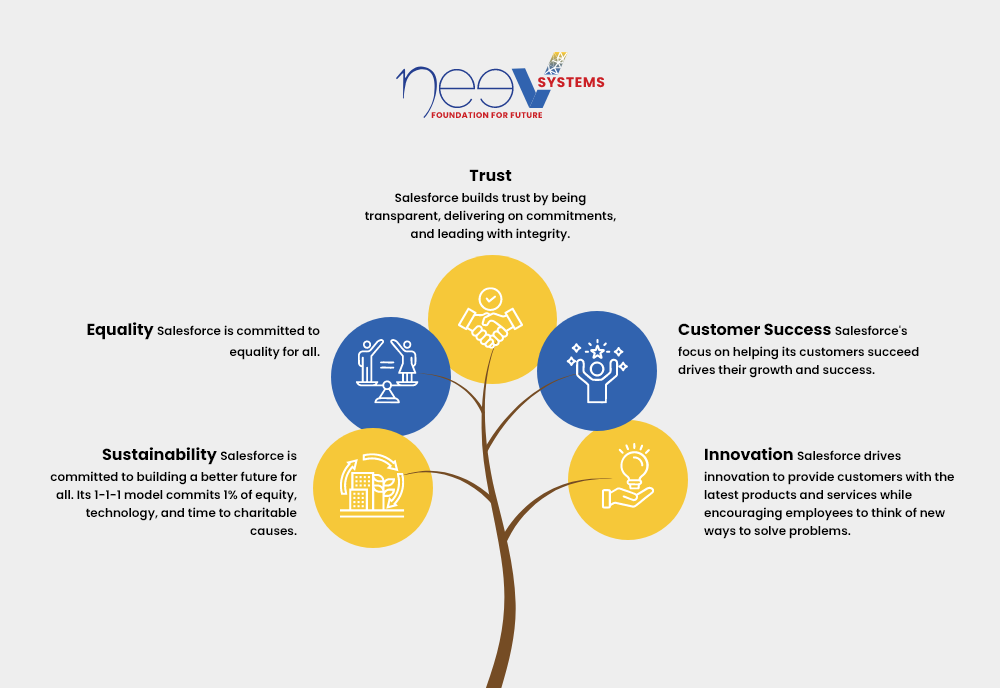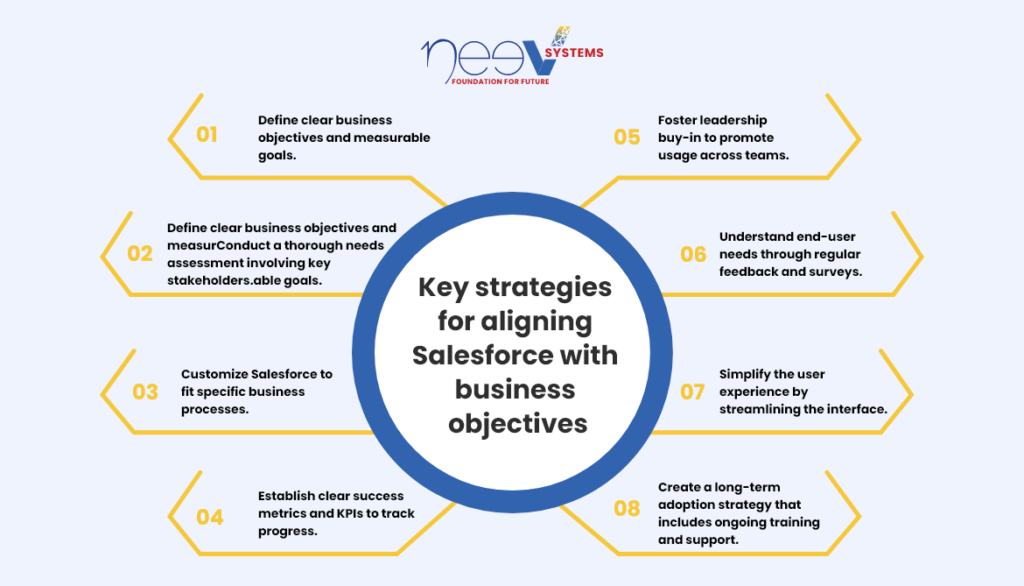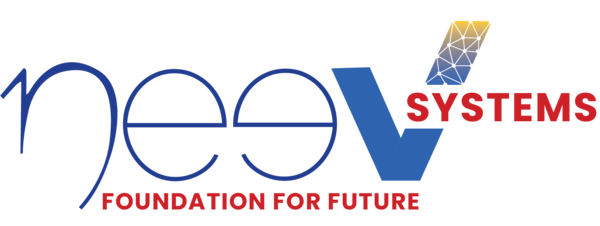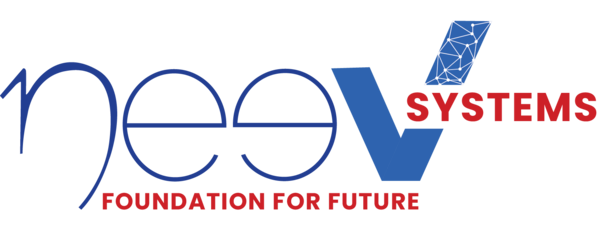Executive Summary
Salesforce has become a vital asset for businesses seeking to enhance customer relationship management and drive growth. However, implementation often falls short, with projects failing to meet their objectives due to insufficient user engagement and inadequate training.
Unlocking Salesforce’s potential requires overcoming resistance to change, data migration issues, and user adoption challenges. Key strategies include leadership buy-in, aligning Salesforce with business goals, and comprehensive training.
Partnering with experts like Neev Systems can kickstart this transformative journey. We ensure businesses implement Salesforce and achieve sustainable growth and enhanced customer satisfaction.
Key Takeaways
- More than half of CRM projects fail due to insufficient user engagement; prioritize strategies to enhance user involvement with Salesforce.
- Ensure teams understand how to use Salesforce features to unlock data value effectively.
- Enhance decision-making by integrating AI tools within Salesforce.
- Secure executive support early in implementation to promote broader team acceptance and commitment.
Streamline the Salesforce interface to focus on essential features relevant to users’ tasks, improving usability and engagement.
Salesforce has emerged as a cornerstone for businesses aiming to enhance customer relationship management (CRM) and drive growth. Yet its implementation often falls short of expectations.
This disconnect raises a critical question for leaders and decision-makers: how can a tool designed to empower teams and boost revenue end up gathering digital dust?
Research reveals that nearly 55% of CRM projects fail to meet their objectives due to insufficient user engagement and inadequate training. This underutilization is alarming, with reports showing that less than 37% of sales representatives actively engage with their CRM systems.
Businesses must adopt a strategic approach to addressing these common challenges to capitalize on Salesforce’s opportunities. This involves unlocking data value in business by ensuring that teams understand how to leverage Salesforce’s features effectively.
Moreover, integrating AI capabilities can enhance decision-making processes, further unlocking business value with Salesforce and AI.
Businesses must acknowledge that proficient Salesforce adaptation is the key to success in a competitive, data-driven market. This requires equipping their teams with the necessary skills and knowledge to master the platform’s intricacies.
This blog will explore the common mistakes in Salesforce implementation and provide actionable strategies to help your business navigate these complexities.
What are the five core values of Salesforce?

Common Mistakes in Salesforce Implementation and How to Avoid Them
Even though unlocking the full potential of Salesforce can significantly enhance business productivity and customer relationship management, some common mistakes hinder this implementation’s effectiveness.
Here’s a brief overview:
Resistance to change
Employee reluctance to transition from legacy systems is a significant barrier to successful Salesforce implementation. Many employees may feel comfortable with their existing processes and fear new systems will disrupt their workflow or require them to learn new skills.
To overcome this, it’s essential to involve them early in the implementation process. Here are some strategies:
- Clearly articulate the benefits of Salesforce, emphasizing how it will streamline processes and improve efficiency.
- Engage employees in decision-making by forming a cross-functional team with representatives from various departments.
- Identify and train change champions within teams who can advocate for Salesforce, share positive experiences, and assist peers during the transition.
Data migration challenges
Data migration issues often arise from poor data quality, inadequate mapping, and insufficient cleansing processes. Inaccurate or incomplete data can lead to flawed insights and hinder decision-making.
Steps to ensure data integrity during migration:
- Before migration, conduct a thorough audit of existing data. Remove duplicates, correct inaccuracies, and standardized formats.
- Develop a detailed data mapping plan outlining how existing data fields correspond to Salesforce fields. This ensures that all relevant data is transferred accurately.
- Implement a testing phase where migrated data is validated for accuracy before going live. This can involve running reports to check for discrepancies.
User adoption hurdles
The complexity of Salesforce features can overwhelm users, leading to low engagement and insufficient platform usage.
Tips to enhance user comfort and proficiency:
- Create role-specific training sessions focusing on the features most relevant to each user group. Use hands-on exercises that mimic real-world scenarios.
- Establish a support system for users to seek help after training. This could include FAQs, user manuals, or access to a dedicated support team.
- Regularly collect feedback from users about their experiences with Salesforce. Use this information to refine training materials and address common pain points.

Ready to Elevate Your Business Operations?
Integration complexities
Integrating Salesforce with existing systems (such as ERP or marketing automation tools) often presents significant challenges due to compatibility issues or lack of clear integration pathways.
To achieve seamless integration:
- Conduct a comprehensive analysis of all existing systems and workflows before implementation. Identify key integration points.
- Consider using middleware tools that start integration between Salesforce and other applications, ensuring smooth data flow.
- Engage with experienced consultants specializing in Salesforce integrations to guide the process and troubleshoot potential issues.
Lack of clear implementation strategy
An unstructured rollout plan can lead to confusion, delays, and, ultimately, project failure due to the misalignment of goals and objectives.
Here’s how you can create a clear implementation strategy:
- Establish SMART goals for what you want to achieve with Salesforce, such as improved sales tracking and enhanced customer service.
- Create a detailed timeline that outlines key milestones throughout the implementation process. This should include phases for planning, migration, training, and evaluation.
- Schedule regular check-ins to assess progress against goals and timelines. Adjust plans as necessary based on these evaluations.
Insufficient training and support
Providing only the initial training sessions without ongoing support can decrease user competence over time.
Here’s what businesses can do to ensure long-term user competence:
- Develop an ongoing training program with advanced sessions as users become more familiar with Salesforce.
- Create a network of Salesforce champions within teams who can provide peer support and share best practices.
- Provide easily accessible resources such as online tutorials, webinars, or community forums where users can seek assistance anytime.
Customization complexity
Over-customization of Salesforce can lead to increased maintenance needs and complications during updates or upgrades.
Here’s how you can strike the right balance between customization and standardization:
- Before customizing Salesforce, evaluate whether specific features are necessary for business operations or if standard functionalities will suffice.
- Avoid creating excessive custom fields. Instead, use existing options wherever possible.
- Periodically review customizations to ensure they meet business needs without causing unnecessary complexity.
Governance and user management issues
Poorly defined roles and permissions can lead to security risks, inefficiencies in workflow management, and unauthorized access to sensitive information.
To establish effective governance:
- Develop a comprehensive role matrix outlining user roles within Salesforce and associated permissions.
- Conduct regular audits of user access rights to ensure compliance with business policies and adjust permissions as needed.
- Train all users on governance policies related to data access and security best practices.
Transforming Customer Order Management for Cepheid Using Salesforce
Due to its reliance on multiple shared Outlook mailboxes, Cepheid faced significant challenges managing customer orders and quotes. This led to inefficiencies in processing requests, manual task assignments, tracking open requests, and generating timely reports. The existing system hindered response times and overall customer satisfaction.
Neev Systems implemented an automation solution using UiPath to streamline Cepheid’s order management process. The automated system reads all incoming emails and creates cases in Salesforce without manual intervention. This solution starts end-to-end tracking of customer requests, automatically assigns tasks, and ensures predictable response times.
The results:
- The automation reduced manual processing time significantly, improving order and quote turnaround times.
- Real-time tracking of customer requests allowed for better prioritization and management.
- The ability to generate accurate reports enabled Cepheid to meet service level agreements (SLAs) consistently.
Key strategies for aligning Salesforce with business objectives

Salesforce Implementation Best Practices to Avoid Common Mistakes
Successful Salesforce implementation requires avoiding common pitfalls. Here’s a list of the best practices you can adopt to do so:
Leadership buy-in
Executive support is critical for promoting Salesforce usage across teams. When leaders actively endorse the platform, they set a positive tone that encourages broader acceptance among employees. This support can significantly influence the implementation’s overall success.
- Engage executives early in the process by showcasing how Salesforce aligns with business goals.
- Update them regularly on progress to reinforce their commitment and solicit their input. This involvement boosts morale and helps address any concerns during implementation.
Aligning with business objectives
Adopting Salesforce as a vital tool for achieving business goals is essential for user engagement. When employees see how the platform directly contributes to their success, they are more likely to embrace and adopt it.
- Communicate how Salesforce will help achieve specific business objectives, such as increasing sales efficiency or improving customer service.
- Use real-world examples and case studies to illustrate its impact and ensure that all teams understand the value it brings to their roles.
Creating a long-term adoption strategy
A long-term sustainable plan that includes onboarding, training, and continuous support mechanisms is crucial for sustained success. Without this strategy, businesses may struggle with user adoption over time.
- Develop a structured onboarding program that gradually introduces users to Salesforce features.
- Implement ongoing training sessions and create a support network where users can share experiences and seek assistance. Regularly assess training effectiveness and adapt programs based on feedback.
Establishing clear success metrics
Setting measurable objectives allows businesses to track progress and celebrate milestones throughout implementation. This practice helps companies maintain momentum and demonstrate the value of Salesforce within the industry.
- Define specific KPIs related to user adoption, data accuracy, and system performance before going live.
- Regularly review these metrics to identify areas for improvement and celebrate achievements with the team to reinforce positive behaviors.
Understanding end-user needs
Conducting surveys and gathering user feedback is vital for tailoring Salesforce to meet their requirements. This understanding fosters a sense of ownership and encourages engagement with the platform.
- Implement regular feedback loops where users can voice their opinions on system functionality and suggest improvements.
- Use this feedback to make informed adjustments to the platform, ensuring it remains relevant and user-friendly.
Simplifying the user experience
A clean, intuitive Salesforce interface emphasizing essential features can dramatically improve user engagement. Overly complex interfaces often prevent users from fully leveraging Salesforce’s potential.
- Customize the interface to each user role, highlighting relevant key features and streamlining navigation.
- Minimize clutter and ensure users have quick and easy access to necessary tools.
Unlocking Salesforce ROI and Maximizing Business Impact
Every day without Salesforce is a day your competitors might be pulling ahead – outperforming you in customer retention, deal velocity, and market insights. But here’s the catch: success doesn’t come from the tool alone but from how you implement it.
The stakes are high for decision-makers who won’t just invest in a platform but reshape how their teams operate, how their customers engage, and, ultimately, how their business grows. For Salesforce Administrators, Sales Ops Managers, CRM Specialists, and Business Analysts, the challenge is ensuring this transformation is effective and enduring.
At Neev Systems, we are ready to partner with you on this transformative journey with our 360-degree Salesforce strategy.
As an official Salesforce partner, we work closely with you to tailor your Salesforce solution to your specific needs. From p; planning and implementation to operations and innovation, our team of experts ensures alignment with your business objectives. We are dedicated to delivering exceptional quality, value, and performance to our clients and continuously improving our skills and knowledge.

Take Charge of Your Future Today

Manohar Reddy Ramreddygari
With 12+ years in the Salesforce ecosystem, Manohar specializes in delivering solutions across Sales, Service, Experience, and Revenue Clouds. Proficient in Lightning Web Components, Einstein Bots, and CPQ, he ensures seamless integration with external platforms. Manohar focuses on leveraging Salesforce technologies to optimize operations and drive strategic growth.


